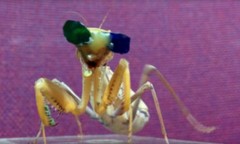By Steve Pak, | February 13, 2016

Mini Brains
John Hopkins University (JHU) researchers have created "mini brains" from humans' neurons and cells that could revolutionize drug testing and end the use of animals for neurological research. The housefly-size ball-shaped organs have many characteristics of a full-size human brain and could be mass produced.
Like Us on Facebook
Scientists at JHU's Bloomberg School of Public Health designed the tiny brains. Since they are standardized they would be useful for lab experiments requiring active brains, according to Gizmodo.
The researchers' invention were presented on February 12, Friday at the American Association for the Advancement of Science conference. It is being held in Washington, D.C.
The little brains called "organoids" are produced from adult human stem cells. They are more ethical than lab animals' brains including mice and rats.
In addition, using the mini brain involves better quality science. The reason is that animals including genetically modified (GM) versions are bad models of human diseases.
A 2016 study published in the journal JAMA stressed this point. It revealed that even high-quality scientific studies with animals would have poor results when performed in human clinical trials.
Thomas Hartung was a lead developer of JHU's mini-brain project. He pointed out to Gizmodo that humans are not 150-pound rats, while the rodents only live for two years.
Hartung's research team built the miniature brains by slowly converting GM stem cells into brain cells. They used cells reprogrammed from skin, which avoids ethical issues and collects them from patients with a disease.
JHU researchers first made little brains in test tubes during 2013. Now the scientists only need around eight weeks to grow them. They can grow up to 100 units from one petri dish, and each batch can produce hundreds of thousands of copies.
The researchers can then study the neuron's reaction to particular drugs. Other mini brains have been produced including those by Harvard researchers in 2014 but JHU's invention is the most standardized.
Hartung explained that the mini brains can think but their functioning is just mechanical unlike real human minds. They are creating electricity but the neurons are trying to communicate with the other brain cells, according to The Guardian.
-
Use of Coronavirus Pandemic Drones Raises Privacy Concerns: Drones Spread Fear, Local Officials Say

-
Coronavirus Hampers The Delivery Of Lockheed Martin F-35 Stealth Fighters For 2020

-
Instagram Speeds Up Plans to Add Account Memorialization Feature Due to COVID-19 Deaths

-
NASA: Perseverance Plans to Bring 'Mars Rock' to Earth in 2031

-
600 Dead And 3,000 In The Hospital as Iranians Believed Drinking High-Concentrations of Alcohol Can Cure The Coronavirus

-
600 Dead And 3,000 In The Hospital as Iranians Believed Drinking High-Concentrations of Alcohol Can Cure The Coronavirus

-
COVID-19: Doctors, Nurses Use Virtual Reality to Learn New Skills in Treating Coronavirus Patients











